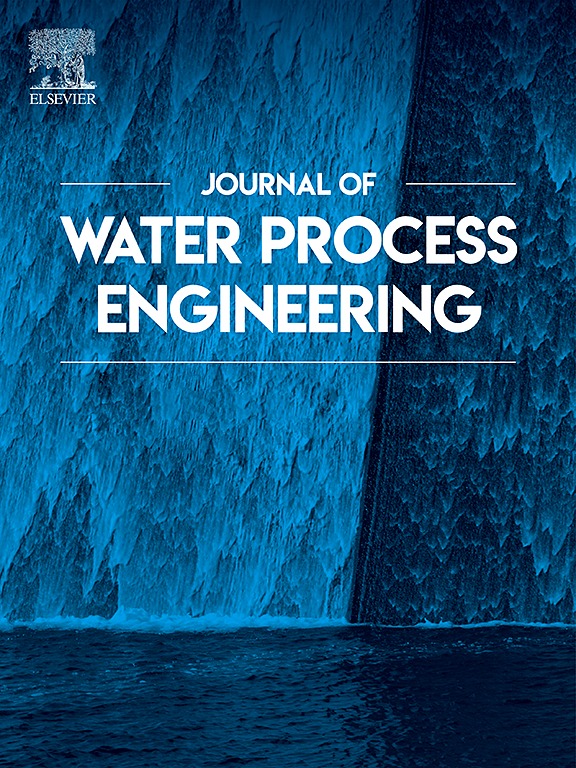Enhanced degradation of rhodamine B by UV/Co3O4@BC/PMS system: Performance and mechanism
IF 6.3
2区 工程技术
Q1 ENGINEERING, CHEMICAL
引用次数: 0
Abstract
The degradation of rhodamine B (RhB), a commonly used dye in the textile industry, is a concern in dye wastewater treatment. Advanced oxidation technology using Peroxymonosulfate (PMS) shows promise due to its highly asymmetry molecular structure. To enhance RhB removal efficiency, a novel catalyst, called Co3O4@BC, was developed. This catalyst consists of cobalt oxide (Co3O4) loaded onto biochar (BC). Additionally, a UV/Co3O4@BC/PMS system was developed. The photocatalytic degradation performance of RhB by this system was investigated. With the addition of only 20 mg·L−1 of Co3O4@BC, a degradation rate of 99.8 % for RhB was achieved in the system within 25 min, a 56 % improvement compared to the system without Co3O4@BC. Additionally, when the concentration of peroxymonosulfate (PMS) was increased from 0.02 g·L−1 to 0.4 g·L−1, the degradation rate increased by 42.5 %. As the concentration of Co3O4@BC increased from 5 mg·L−1 to 20 mg·L−1, the degradation rate improved by 15.6 %. When the UV radiation intensity increased from 10 W·m−2 to 120 W·m−2, the degradation rate increased by only 3.3 %. It was found that Co3O4@BC had an excellent ability to activate PMS to generate active species, with the contribution of reactive oxygen species in the order of 1O2>SO4•->•OH. The leaching concentration of cobalt ions in UV/Co3O4@BC/PMS system was 121.1 μg·L−1, which still meets the specified limit by the Environmental Quality Standard for Surface Water (Gb3838-2022). It well below the specified limit of 1.0 mg·L−1. Therefore, the use of the UV/Co3O4@BC/PMS system is practical and economically feasible from both economic and environmental perspectives.

UV/Co3O4@BC/PMS系统对罗丹明B的强化降解:性能及机理
罗丹明B (rhodamine B, RhB)是纺织工业中常用的染料,其降解是染料废水处理中关注的问题。由于其高度不对称的分子结构,采用过氧单硫酸根(PMS)作为先进的氧化技术具有广阔的应用前景。为提高RhB的脱除效率,研制了一种新型催化剂Co3O4@BC。该催化剂由负载在生物炭(BC)上的氧化钴(Co3O4)组成。此外,还开发了UV/Co3O4@BC/PMS系统。研究了该体系光催化降解RhB的性能。当只添加20 mg·L−1的Co3O4@BC时,系统在25 min内对RhB的降解率达到99.8%,与不添加Co3O4@BC的系统相比提高了56%。此外,当PMS浓度从0.02 g·L−1增加到0.4 g·L−1时,降解率提高了42.5%。当Co3O4@BC浓度从5 mg·L−1增加到20 mg·L−1时,降解率提高了15.6%。当紫外辐射强度从10 W·m−2增加到120 W·m−2时,降解率仅提高3.3%。结果发现Co3O4@BC具有很好的激活PMS生成活性物质的能力,其中活性氧的贡献顺序为:122 >;SO4•->;•OH。UV/Co3O4@BC/PMS体系中钴离子的浸出浓度为121.1 μg·L−1,仍满足《地表水环境质量标准》(Gb3838-2022)规定的限量要求。远低于1.0 mg·L−1的规定限值。因此,从经济和环境的角度来看,使用UV/Co3O4@BC/PMS系统是实用和经济可行的。
本文章由计算机程序翻译,如有差异,请以英文原文为准。
求助全文
约1分钟内获得全文
求助全文
来源期刊

Journal of water process engineering
Biochemistry, Genetics and Molecular Biology-Biotechnology
CiteScore
10.70
自引率
8.60%
发文量
846
审稿时长
24 days
期刊介绍:
The Journal of Water Process Engineering aims to publish refereed, high-quality research papers with significant novelty and impact in all areas of the engineering of water and wastewater processing . Papers on advanced and novel treatment processes and technologies are particularly welcome. The Journal considers papers in areas such as nanotechnology and biotechnology applications in water, novel oxidation and separation processes, membrane processes (except those for desalination) , catalytic processes for the removal of water contaminants, sustainable processes, water reuse and recycling, water use and wastewater minimization, integrated/hybrid technology, process modeling of water treatment and novel treatment processes. Submissions on the subject of adsorbents, including standard measurements of adsorption kinetics and equilibrium will only be considered if there is a genuine case for novelty and contribution, for example highly novel, sustainable adsorbents and their use: papers on activated carbon-type materials derived from natural matter, or surfactant-modified clays and related minerals, would not fulfil this criterion. The Journal particularly welcomes contributions involving environmentally, economically and socially sustainable technology for water treatment, including those which are energy-efficient, with minimal or no chemical consumption, and capable of water recycling and reuse that minimizes the direct disposal of wastewater to the aquatic environment. Papers that describe novel ideas for solving issues related to water quality and availability are also welcome, as are those that show the transfer of techniques from other disciplines. The Journal will consider papers dealing with processes for various water matrices including drinking water (except desalination), domestic, urban and industrial wastewaters, in addition to their residues. It is expected that the journal will be of particular relevance to chemical and process engineers working in the field. The Journal welcomes Full Text papers, Short Communications, State-of-the-Art Reviews and Letters to Editors and Case Studies
 求助内容:
求助内容: 应助结果提醒方式:
应助结果提醒方式:


